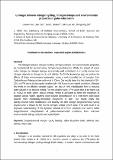Linkages between nitrogen cycling, nitrogen isotopes, and environmental properties in paleo-lake basins
Abstract
The linkages between nitrogen cycling, nitrogen isotopes, and environmental properties are fundamental for reconstructing nitrogen biogeochemistry. While the impact of ocean redox changes on nitrogen isotopes is relatively well understood, it is poorly known how nitrogen responds to changes in pH and salinity. To fill the knowledge gap, we explore the effects of these environmental parameters using a well-controlled set of samples from Carboniferous−Paleogene lake sediments in China. Our results show that the threshold of 10−12‰ in δ15N works to distinguish alkaline (pH > 9) from circum-neutral conditions. Elevated Mo levels in the alkaline samples support the idea of NH3 volatilization from a reducing water column in an alkaline setting. For non-alkaline lakes, δ15N values tend to be higher (up to +10‰) in more saline, anoxic settings, which is attributed to either the expansion of stagnant anoxic waters spurring water-column denitrification or a shift from plant-based toward more microbially dominated ecosystems or both. Our results imply that salinity-induced redox stratification and basicity can alter nitrogen biogeochemical cycling beyond what is shown by the marine nitrogen isotope record alone. This finding will result in an improved understanding of the dynamic controls of δ15N in sediments and lead to better biogeochemical interpretations of paleo-environmental conditions from unknown environmental settings on Earth and beyond Earth.
Citation
Xia , L , Cao , J , Stüeken , E E , Hu , W & Zhi , D 2022 , ' Linkages between nitrogen cycling, nitrogen isotopes, and environmental properties in paleo-lake basins ' , Geological Society of America Bulletin , vol. 134 , no. 9-10 , pp. 2359-2372 . https://doi.org/10.1130/b36290.1
Publication
Geological Society of America Bulletin
Status
Peer reviewed
ISSN
0016-7606Type
Journal article
Description
Funding information: This work was funded by the National Natural Science Foundation of China (no. 41830425). E.E. Stüeken acknowledges funding from a Natural Environment Research Council grant (no. NE/V010824/1).Collections
Items in the St Andrews Research Repository are protected by copyright, with all rights reserved, unless otherwise indicated.

